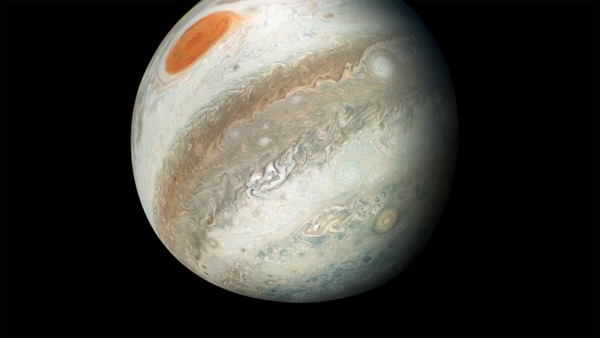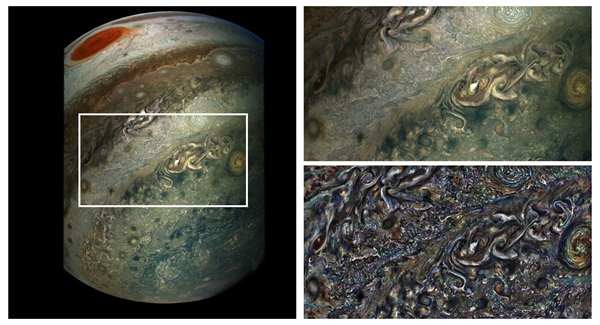Key Takeaways:
JunoCam images presented at the meeting by citizen scientists Gerald Eichstädt and Seán Doran include an animation showing the evolution of swirling features in the giant planet’s atmosphere and a composite image of Jupiter’s cloud tops.
Gerald Eichstädt, a mathematician working as a software professional, has taken two images from JunoCam and reprojected them to the same vantage point to enable a direct comparison between the images and show the subtle motions within the atmosphere. By modelling the movement of individual pixels in the images, he has created an animation that extrapolates the swirling evolution of the vortices in the atmosphere.
Eichstädt explains: “This animation represents a ‘feasibility test’. Building on this initial work, we can add in more variables that will give us a more detailed description and physical understanding of Jupiter’s atmosphere.”
Seán Doran, in collaboration with Eichstädt, has created a new composite image of Jupiter as seen by Juno as it swung away from Jupiter’s south pole on 1st April 2018. Because Jupiter was larger than JunoCam’s field of view when the main portion of the image was taken, Eichstädt rendered four other images to the same viewing geometry to reconstruct a mosaic of the whole planet. Doran then processed the composite image to balance and blend the overlapping components, sharpen the contrast, and fill gaps.
“It’s something of a labour of love that requires plenty of patience,” says Doran. “Energetic particles impact the CCD and produce bright specks. Once I’d finished the processing, I needed to go through and repair a couple hundred of these bright pixels.”
Leigh Fletcher of the University of Leicester, who has co-organised the workshop with the support of Europlanet 2020 Research Infrastructure, says: “The contribution of the Earth-based support campaign to the Juno mission, both professional and amateur, has proven to be invaluable in filling the spatial, temporal, and spectral gaps in Juno’s capabilities. Now two years into the mission, we’ve seen some tremendous new science emerging from this collaboration, and breath-taking imagery of Jupiter’s complex atmosphere that would not have been possible without the talented army of citizen scientists that have been working alongside the JunoCam team every step of the way.”
“The amateur observations are key to detecting and rapid changes of the atmospheric properties in time on shorter time scales than possible from the professional community, whose resources are shared among many different programs. Thus, they not only measure changes between Juno’s close encounters with Jupiter, but they also provide a means to anticipate changes that might influence how future observations can be interpreted, and they could even influence decisions on Juno’s observing strategy in the case of unexpected phenomena,“ says Glenn Orton of Jet Propulsion Laboratory, California Institute of Technology, who is the Juno science team member in charge of coordinating Earth-based observations to extend and enhance the science return from Juno’s investigation of Jupiter and its magnetosphere.
John Rogers of the British Astronomical Association, who co-organised the workshop says: “Many of these people have known each other for years by email addresses and social media alone, so to have them all in one place will be an incredibly special opportunity, fostering new collaborations and cementing existing friendships.”
Follow updates for the workshop through the hashtag #RASJuno on social media.
Two JunoCam images, taken around 8 minutes 41 seconds apart, have been re-projected to the same vantage point, cropped, and enhanced in a context sensitive way. A subtle motion can be perceived through a simple “blink comparison”.
NASA/JPL/SwRI/MSSS/Gerald Eichstädt.
Animation extrapolating the movement of the clouds from JunoCam imagery taken on 1st April 2018.
NASA/JPL/SwRI/MSSS/Gerald Eichstädt












